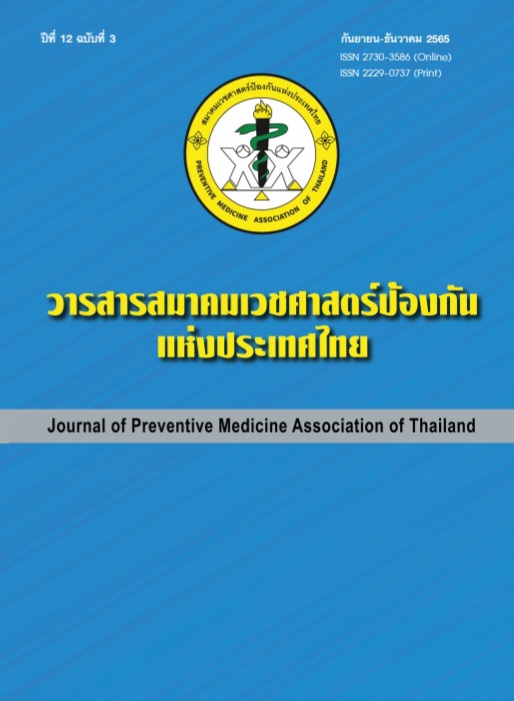Prevalence and Association of Hypertension, Diabetes, Dyslipidemia, Obesity, and Central obesity among Army Areas in Royal Thai Army Personnel
Keywords:
Hypertension, Diabetes, Dyslipidemia, Soldiers, Royal Thai ArmyAbstract
Background: Non-communicable diseases and obesity are one of the leading causes of healthcare issues in Thailand, costing more than 500 million baht per year in prevention and healthcare promotions. The Royal Thai Army has fewer studies on non-communicable diseases than other professions, even though the military is one of the biggest forces in Thailand that has an important role in the preservation of the nation.
Objective: To study the prevalence and association between diabetes mellitus, hypertension, dyslipidemia, obesity, and central obesity and five army areas.
Method: Data from the annual health checkup database of military personnel with 119,210 participants conducted in 2020 were analyzed using descriptive statistics (frequency, mean, standard deviation) and inferential statistics (Chi-square).
Result: The study showed Among 119,210 Army personnel, there were 71,810 persons (60.2%) had at least one disease of diabetes mellitus, hypertension, dyslipidemia, obesity, and central obesity. Among Royal Thai Army personnel, dyslipidemia was the most prevalent (74.5%) followed by obesity (43.0%) and Central obesity (31.8%). Distributed by army areas, Bangkok and neighboring provinces had the highest number of personnel with diseases at 68.1%. The association between the prevalence of Hypertension, Diabetes, Dyslipidemia, Obesity, Central obesity, and Army areas was found (p-value<0.01)
Conclusion: Hypertension, Diabetes, Dyslipidemia, Obesity, and Central are important problems of the Royal Thai Army. Therefore, more detailed studies on the causes of the disease and disease prevention in each army area should be developed. This will be useful to prevent diseases and complications that may occur in the future with a limited budget.
References
World Health Organization. Noncommunicable diseases 2021 [Internet]. 2022 [cited 2021 Nov 5]. Available from: https://www.who.int/news-room/fact-sheets/detail/noncommunicable-diseases.
Mendis S, editor. Global status report on NCDs 2014. Geneve: World Health Organization; 2014.
Aekplakorn W, editor. The 6th final health survey 2019-2020. Nonthaburi: Health System Research Institute; 2021.
Aekplakorn W, editor. The 4th Final Health Survey 2008-2009. Nonthaburi: Health System Research Institute; 2008.
Aekplakorn W, editor. The 5th Final Health Survey 2014. Nonthaburi: Health System Research Institute; 2016.
National Health Security Office. Guideline for management in Nation Health Security Fund 2011. Bangkok: National Health Security Office; 2010.
National Health Security Office. Guideline for management in Nation Health Security Fund 2020. Bangkok: National Health Security Office; 2019.
Miller M. Dyslipidemia and cardiovascular risk: the importance of early prevention. QJM 2009;102(9):657-67.
Akil L, Ahmad HA. Relationships between obesity and cardiovascular diseases in four southern states and Colorado. J health Poor Underserved 2011;22(4 Suppl):61-72.
Ngan WB, Belinga LEE, Nlo'o ASPE, Roche F, Goethals L, Mandengue SH, et al. Surveillance of cardiovascular risk factors in the Fifth Military Sector Health Center, Ngaoundéré, Cameroon: observational study. JMIR Form Res 2020;4(11):e18567.
Sakboonyarat B, Rangsin R, Mittleman MA. Incidence and risk factors of metabolic syndrome among Royal Thai Army personnel. Scientific reports 2022;12(1):1-11.
The Government Public Relations Department. Four regional food [Internet]. 2021 [cited 2022 Mar 1]. Available from: https://thainews.prd.go.th/banner/th/culture_th/ thaifood.php
Sahaspot S, Charoensiri E, Kongkachuichai R. Glycemic index of glutinous and non-glutinous landrace rice varieties using “In vitro rapidly available glucose”. Burapha Science Journal 2015;20(2):1-13.
Wilding JPH. The importance of weight management in type 2 diabetes mellitus. Int J Clin Pract 2014;68(6):682-91.
เบญจวรรณ ชีวยะพันธ์. ความชุกและปัจจัยที่มีความสัมพันธ์กับภาวะไขมันในเลือดผิดปกติในบุคลากรโรงพยาบาลโพธาราม. วารสารหัวหินสุขใจไกลกังวล 2561;3(1):36-45.
Joshi N, Shah C, Mehta H, Gokhle P. Comparative study of lipid profile on healthy smoker and non smokers. Int J Med Sci Public health 2013;2(3):622-6.
Gebreegziabiher G, Belachew T, Mehari K, Tamiru D. Prevalence of dyslipidemia and associated risk factors among adult residents of Mekelle City, Northern Ethiopia. PloS one 2021;16(2):e0243103.
นันทิดา ชุ่มวิเศษ. ปัจจัยที่สัมพันธ์กับภาวะไขมันผิดปกติในเลือดของข้าราชการครูที่มาตรวจสุขภาพที่ โรงพยาบาลสันป่าตอง ปี 2552. วารสารสาธารณสุขล้านนา 2554;7(1):25-38.
สมาคมความดันโลหิตสูงแห่งประเทศไทย. แนวทางการรักษาโรคความดันโลหิตสูงในเวชปฏิบัติทั่วไป พ.ศ.2562. กรุงเทพฯ : สมาคมความดันโลหิตสูงแห่งประเทศไทย; 2562.
Singha S, editor. Thai national strategic plan for reduce salt and sodium consumption 2016-2025. Nonthaburi : Ministry of Health; 2016.
Downloads
Published
Versions
- 2023-01-23 (3)
- 2023-01-17 (2)
- 2023-01-16 (1)
How to Cite
Issue
Section
License
Copyright (c) 2023 Journal of Preventive Medicine Association of Thailand

This work is licensed under a Creative Commons Attribution-NonCommercial-NoDerivatives 4.0 International License.
บทความที่ลงพิมพ์ในวารสารเวชศาสตร์ป้องกันแห่งประเทศไทย ถือเป็นผลงานวิชาการ งานวิจัย วิเคราะห์ วิจารณ์ เป็นความเห็นส่วนตัวของผู้นิพนธ์ กองบรรณาธิการไม่จำเป็นต้องเห็นด้วยเสมอไปและผู้นิพนธ์จะต้องรับผิดชอบต่อบทความของตนเอง






